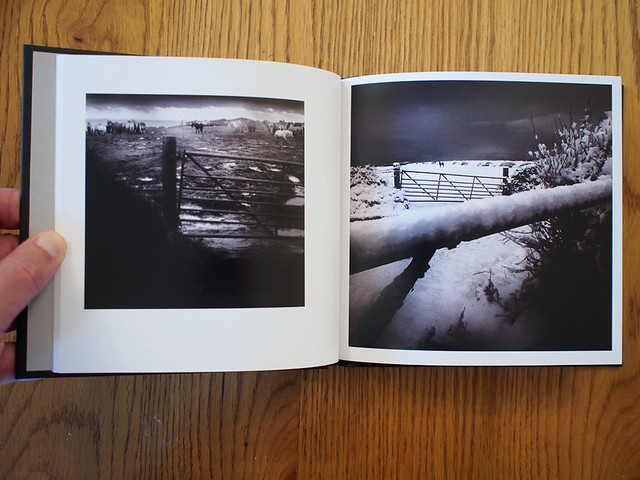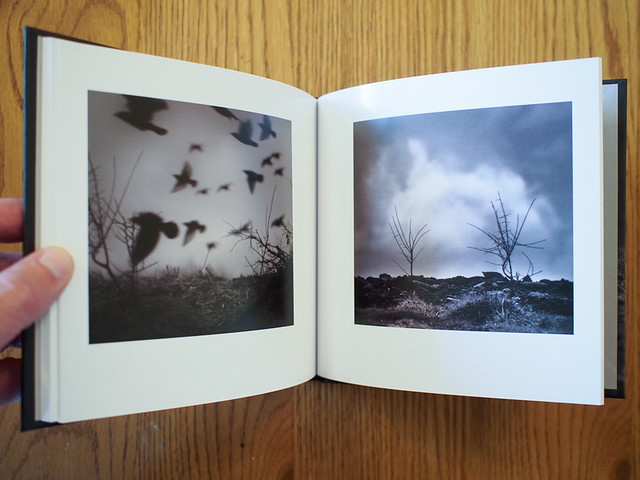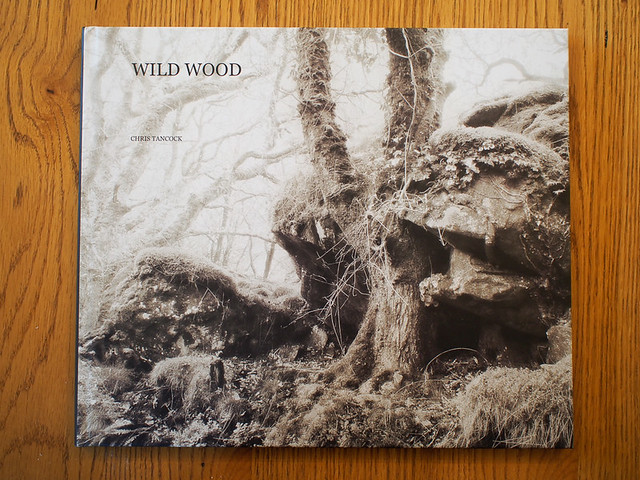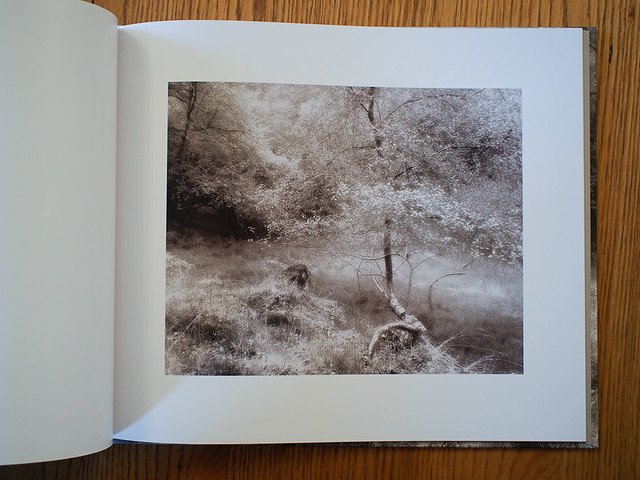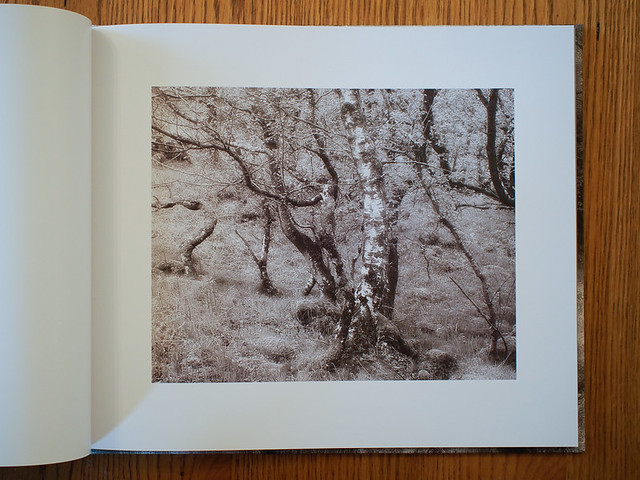Showing posts with label landscape. Show all posts
Showing posts with label landscape. Show all posts
Friday, 3 October 2014
Morning glory
There are many occasions when my wife and I will take our dog for a walk in the beautiful countryside which surrounds us, when shortly into the walk she will say -
"Did you bring your camera with you?'
To which I will reply
"No, I haven't."
Almost inevitably a few minutes later a scene worthy of capture will present itself and I curse myself for not having bothered to pick up my camera and thrown it over my shoulder.
Many a missed opportunity, but this morning was the exception and I must learn the lesson to always have a camera with me. It's an old cliche but a very true one.
Within five minutes of leaving our car we came across this scene. The sun was rising, the morning mist lifting and the dew on the ground added another attractive element to this autumnal scene. The birds flew around the lone tree in the field and the distant farm buildings to the right completed the composition. I took the shot and we continued our walk. I am guessing but I would think that five or ten minutes later the early morning mist would have been burnt away and this glorious view would have been lost.
For me this is a very special time of year and I am looking forward to the weeks and months ahead. Needless to say I will try and remember to have a camera with me at all times.
Sunday, 9 March 2014
Taking inspiration from other artists - Chris Tancock
A few weeks ago I wrote about how I like to take inspiration from other artists - or to be more precise, how I like to enjoy the work of more accomplished artists and perhaps try and learn something in the process.
Today I just want to write a few words about the Welsh photographer - Chris Tancock, who describes himself as a rural documentary photographer as opposed to a landscape photographer, even though he takes photos of the countryside in which he lives.
I first came across his work when on holiday in Pembrokeshire in Wales a few years ago. His photographs were for sale in a gallery near St Davids and I found them particularly striking. The project was called 'Quiet Storm', and included a number of dramatic colour images of the Welsh landscape.
Later I found more of his work on the web, only to discover that he much prefers to work in black and white. Amongst his more recent projects are 'Beating the Bounds', 'Off the Beaten Track', 'Farm' and 'The Dowrog'. I greatly admire his dedication to the work he produces. Beating the Bounds for example is a project spread over 5 years, where he walks the boundaries of 5 meadows, twice a day, every day, come rain or shine, observing and capturing the ever changing 'story' of the landscape he witnesses. The project is still incomplete but I am lucky enough to have the current version of his book called 'Beating the Bounds' which is published by Blurb.
I also have another book by Chris Tancock called 'Wildwood' again by the same publisher.
To me these images are not what might be termed 'classic' landscapes, where the photographer has used a well established formula to arrive at the finished photograph. It is hard for me to put into words the ethos of Chris Tancock's approach to photography, so to give you a flavour of his style I have included a quote from an interview with the magazine 'Onlandscape' in which he said -
"I don't want to hurt peoples feelings, but I don't like boulders in the foreground, sunsets in the background, diagonals in between them, repeated again and again and again, hunting the countryside until you find these things. What does it tell you about the landscape? Nothing. It tells you about composition and the photographer, it doesn't tell you anything about the landscape, but they're commercially viable. They are very easily read images. People forget we read images on different levels and an image like that has the reading age of a 5 year old, its the equivalent of a Janet and John book".
Strong, heartfelt words and perhaps the reason why his images are documentary in style. His photographs may not necessarily be called beautiful but they certainly tell a story about the landscape and the countryside in which he lives. Many have a mysterious quality about them, little details contained within the image which are not always noticed on first viewing. Personally I think there is a beauty about the them and I very much enjoy following his latest work which he posts on Pictify.
If you are interested in learning more about Chris Tancock and his individual approach to his work, then you can read the full interview with "Onlandscape' here.
For now I shall continue to admire his work and try and learn something from his approach to this particular style of documentary photography.
Today I just want to write a few words about the Welsh photographer - Chris Tancock, who describes himself as a rural documentary photographer as opposed to a landscape photographer, even though he takes photos of the countryside in which he lives.
I first came across his work when on holiday in Pembrokeshire in Wales a few years ago. His photographs were for sale in a gallery near St Davids and I found them particularly striking. The project was called 'Quiet Storm', and included a number of dramatic colour images of the Welsh landscape.
Later I found more of his work on the web, only to discover that he much prefers to work in black and white. Amongst his more recent projects are 'Beating the Bounds', 'Off the Beaten Track', 'Farm' and 'The Dowrog'. I greatly admire his dedication to the work he produces. Beating the Bounds for example is a project spread over 5 years, where he walks the boundaries of 5 meadows, twice a day, every day, come rain or shine, observing and capturing the ever changing 'story' of the landscape he witnesses. The project is still incomplete but I am lucky enough to have the current version of his book called 'Beating the Bounds' which is published by Blurb.
I also have another book by Chris Tancock called 'Wildwood' again by the same publisher.
To me these images are not what might be termed 'classic' landscapes, where the photographer has used a well established formula to arrive at the finished photograph. It is hard for me to put into words the ethos of Chris Tancock's approach to photography, so to give you a flavour of his style I have included a quote from an interview with the magazine 'Onlandscape' in which he said -
"I don't want to hurt peoples feelings, but I don't like boulders in the foreground, sunsets in the background, diagonals in between them, repeated again and again and again, hunting the countryside until you find these things. What does it tell you about the landscape? Nothing. It tells you about composition and the photographer, it doesn't tell you anything about the landscape, but they're commercially viable. They are very easily read images. People forget we read images on different levels and an image like that has the reading age of a 5 year old, its the equivalent of a Janet and John book".
Strong, heartfelt words and perhaps the reason why his images are documentary in style. His photographs may not necessarily be called beautiful but they certainly tell a story about the landscape and the countryside in which he lives. Many have a mysterious quality about them, little details contained within the image which are not always noticed on first viewing. Personally I think there is a beauty about the them and I very much enjoy following his latest work which he posts on Pictify.
If you are interested in learning more about Chris Tancock and his individual approach to his work, then you can read the full interview with "Onlandscape' here.
For now I shall continue to admire his work and try and learn something from his approach to this particular style of documentary photography.
Sunday, 12 January 2014
Always grab the opportunity
 |
| Across Loch Eil |
There are occasions when a quickly taken shot can make for a pleasing image even if there is virtually no time taken to adjust the camera settings and compose the picture.
This photograph of Loch Eil in Scotland is a case in point. Back in 2011, I was travelling by train from Glasgow to Mallaig on the west coast. Having left the town of Fort William the train continues it's journey taking in some spectacular countryside along the way. In fact this route is considered to be one of the finest railway journeys in the world. As the track passed alongside the Loch, the cloudscape and light across the water just had to be captured. I really only had time to turn the camera on, swiftly compose the shot through the window of my carriage and press the shutter. Although the train was not moving that fast, if I had taken the time to check or alter any of the settings on the camera, the opportunity to take press the shutter would have been lost several hundred yards back down the track, as this view soon disappeared behind a line of trees along the shoreline.
The image straight out of the camera was pretty poor. In particular the horizon was far from level and the exposure was definitely out. Fortunately I was able to straighten and crop the image and improve the overall tone in Lightroom. I think the final image is very pleasing. It may not be prefect and I know that had I been standing by the loch, with a tripod and time to move around, I would have composed and exposed the photograph differently. Nevertheless as a quick opportunistic shot taken through the window of a moving train, it still works for me, and I would rather have the image in my collection than nothing at all.
This photograph of Loch Eil in Scotland is a case in point. Back in 2011, I was travelling by train from Glasgow to Mallaig on the west coast. Having left the town of Fort William the train continues it's journey taking in some spectacular countryside along the way. In fact this route is considered to be one of the finest railway journeys in the world. As the track passed alongside the Loch, the cloudscape and light across the water just had to be captured. I really only had time to turn the camera on, swiftly compose the shot through the window of my carriage and press the shutter. Although the train was not moving that fast, if I had taken the time to check or alter any of the settings on the camera, the opportunity to take press the shutter would have been lost several hundred yards back down the track, as this view soon disappeared behind a line of trees along the shoreline.
The image straight out of the camera was pretty poor. In particular the horizon was far from level and the exposure was definitely out. Fortunately I was able to straighten and crop the image and improve the overall tone in Lightroom. I think the final image is very pleasing. It may not be prefect and I know that had I been standing by the loch, with a tripod and time to move around, I would have composed and exposed the photograph differently. Nevertheless as a quick opportunistic shot taken through the window of a moving train, it still works for me, and I would rather have the image in my collection than nothing at all.
Saturday, 9 November 2013
Less is more when capturing the South Downs
 |
| Downland fence |
It is hard to believe that two months have passed since I completed my walk along the South Downs Way and here I am still writing about the experience and the photographic lessons I learnt.
I guess that if you mention the South Downs to a bystander they will conjure up in their minds a wide expansive view of the Sussex Weald and Downland. Large vistas which are truly beautiful but incredibly difficult to capture in a photograph. It is perhaps one of the reasons so called 'holiday snaps' never quite do justice to the scene we witnessed. We are tempted to try and include everything we see in one photo and whilst it may be a good record of what we saw, it often fails as a photograph. It might lack a good composition, any form of focal point to draw the eye, be poorly lit or quite simply not truly capture the feelings that the photographer felt at the time.
I can't deny that some of the images I took fell into the 'large vista' category but I was also mindful to look closer and try and simplify the landscape through careful composition, concentrating on just two or three key elements and in so doing try and capture the essence of the South Downs and not just the grand view.
So this entry includes a selection of images all taken from the South Downs Way, where less is hopefully more.
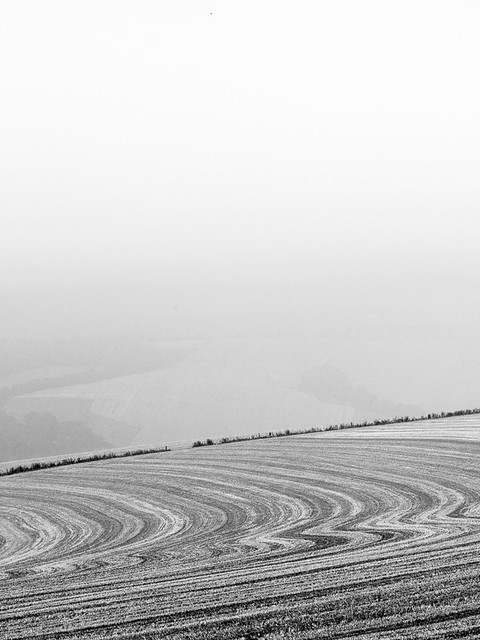 |
| Field of curves |
 |
| Straw bale |
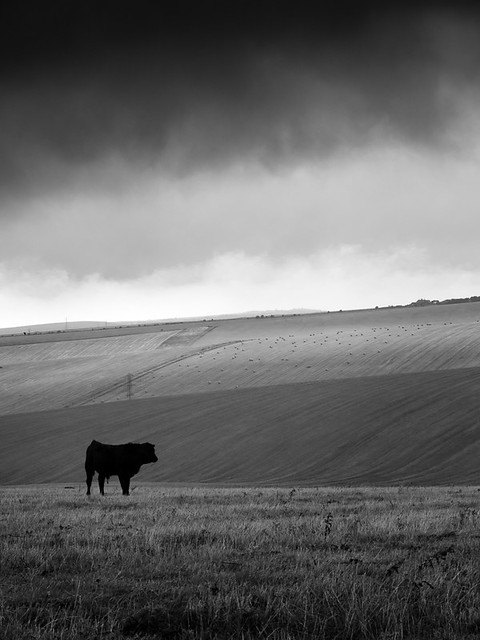 |
| Lone cow |
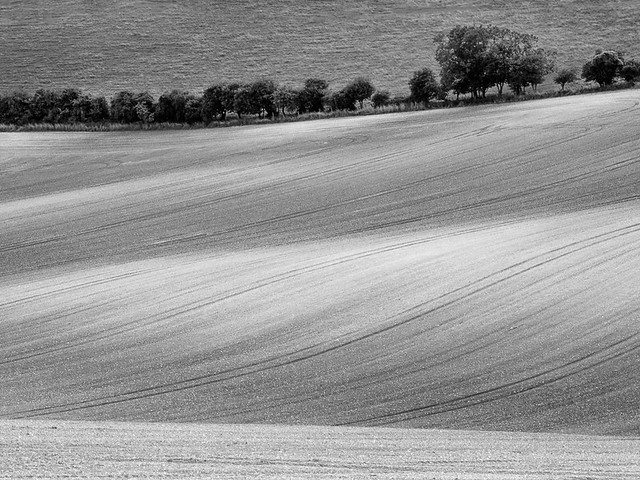 |
| Downland field |
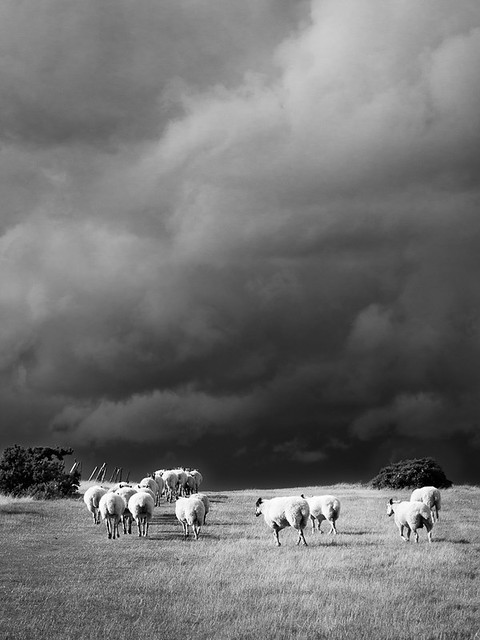 |
| No shelter |
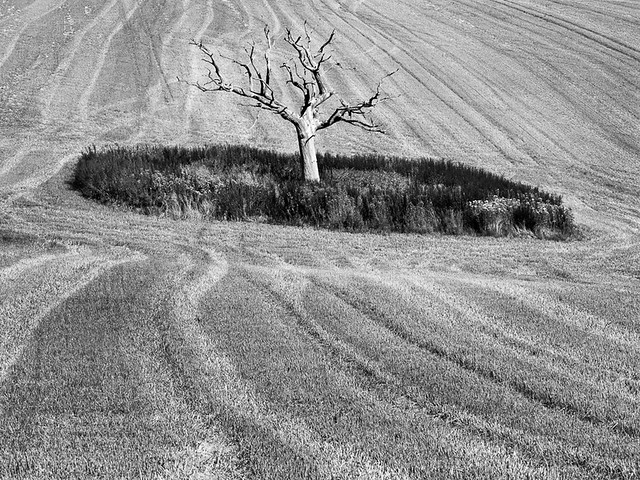 |
| Dead tree |
 |
| Gateway to the sky |
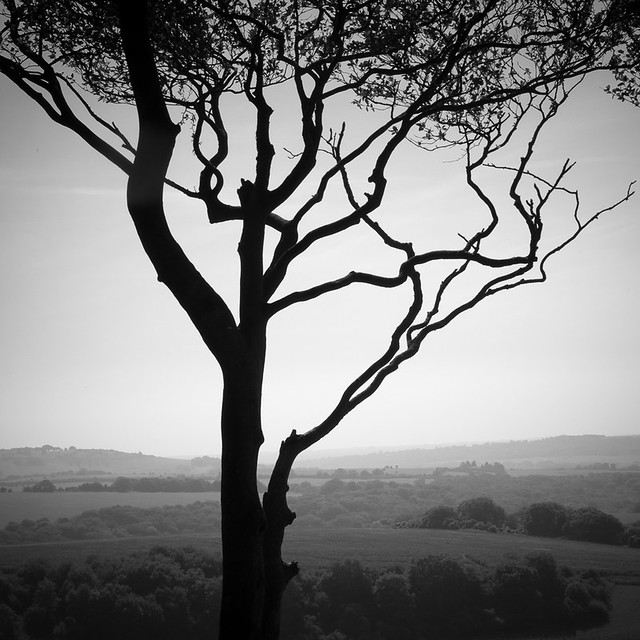 |
| Twisted Chanctonbury tree |
Do these photographs capture something about the South Downs?
Do they capture the feelings I experienced when I first saw and composed the image in the viewfinder? Do they do justice to the beauty of the area and its countryside?
So many questions and of course I have my own answers and anyone viewing these images will have their own opinions. In the end they are the view I chose to take, my interpretation and my treatment. They give me pleasure and I hope others might just feel the same way.
Thank you for reading my 'blog' and do leave a comment if you have anything you would like to say.
Sunday, 18 August 2013
Harvest time
The time to harvest the crops is upon us. It's the season when farmers have to make the sometimes difficult decision as is to when is the optimum time to roll out the combine harvester, maximise the yield and not to risk a change in the weather, as this has the potential to do untold damage to the crop, not to mention their bank balances.
The South Downs are covered in fields of wheat and on a recent walk the threatening shower clouds started to form, although the rain never fell one me fotunately.
This post of just four entries captures for me something of the beautiful downland scenery at this time of year.
I was drawn to the scene below of the old tree and the flowing lines of the field which had recently been harvested. A week later I returned to the same spot and these distinct lines were no longer so clearly defined. The 'decisive moment' of landscape photography.
In the next image, which I have called 'Harvest Enemy', I have tried to capture the mood of a brewing storm which threatens the crop of wheat in the field below.
I rarely process my work in colour but on this occasion I particularly liked the the contrast in colour between the field of wheat and the threatening sky. I also used a 'letterbox' crop instead of a '5x4' crop which was applied to the mono version of the same RAW file.
The South Downs are covered in fields of wheat and on a recent walk the threatening shower clouds started to form, although the rain never fell one me fotunately.
This post of just four entries captures for me something of the beautiful downland scenery at this time of year.
 |
| Harvest shower |
I was drawn to the scene below of the old tree and the flowing lines of the field which had recently been harvested. A week later I returned to the same spot and these distinct lines were no longer so clearly defined. The 'decisive moment' of landscape photography.
 |
| The harvest tree |
In the next image, which I have called 'Harvest Enemy', I have tried to capture the mood of a brewing storm which threatens the crop of wheat in the field below.
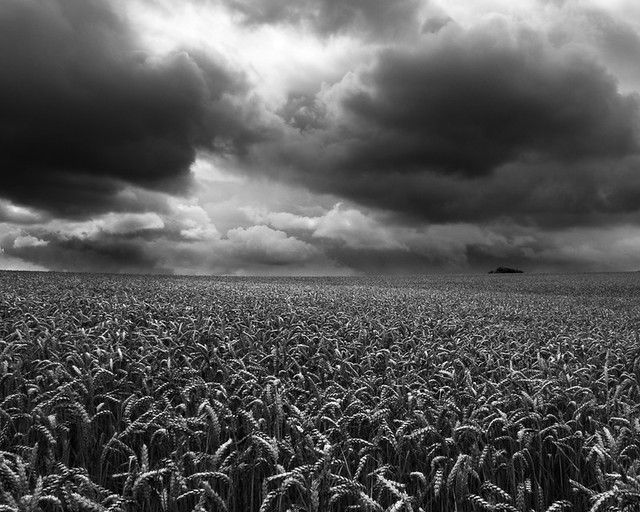 |
| Harvest enemy |
I rarely process my work in colour but on this occasion I particularly liked the the contrast in colour between the field of wheat and the threatening sky. I also used a 'letterbox' crop instead of a '5x4' crop which was applied to the mono version of the same RAW file.
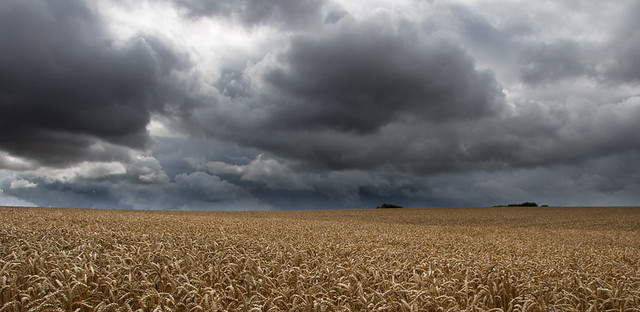 |
| Harvest enemy in colour |
I love this time of year as the summer draws to a close and the more changeable weather of autumn starts to appear. Will I be drawn to more colour work to capture the wonderful autumnal colours?, This I don't know, only time will tell. Whatever happens, I will be out with my camera doing what I enjoy most!
Tuesday, 30 July 2013
On the Way
In April 2011 The South Downs became a National Park. Designated an Area of Outstanding Natural Beauty along the south coast of England, the Park is spread over three counties, Hampshire, West Sussex and East Sussex. It covers a total area of 1600km2 and more than 110,000 people live within its boundaries.
The Park is also home to a National Trail or long distance footpath known as the South Downs Way, which is 160km or 100 miles in length. It starts in the city of Winchester in the west and finishes at the western end of the promenade in Eastbourne.
I am fortunate to live just outside the National Park boundary but it only takes a few minutes in the car and I can be in the heart of of this beautiful part of the world.
Whilst I love to travel further afield with my camera and explore areas such as Scotland or The Lake District, there is plenty to see and photograph right on my doorstep. So a few days ago I decided to walk a section of the South Downs Way. Starting in the car park to the south of Cocking Village I headed west to the tiny hamlet of Hooksway and then returned to Cocking. The walk was just under 11 miles and the scenery along the route was typical of the chalk downland which forms the escarpment of the South Downs.
Here are some images from the walk.
The Park is also home to a National Trail or long distance footpath known as the South Downs Way, which is 160km or 100 miles in length. It starts in the city of Winchester in the west and finishes at the western end of the promenade in Eastbourne.
I am fortunate to live just outside the National Park boundary but it only takes a few minutes in the car and I can be in the heart of of this beautiful part of the world.
Whilst I love to travel further afield with my camera and explore areas such as Scotland or The Lake District, there is plenty to see and photograph right on my doorstep. So a few days ago I decided to walk a section of the South Downs Way. Starting in the car park to the south of Cocking Village I headed west to the tiny hamlet of Hooksway and then returned to Cocking. The walk was just under 11 miles and the scenery along the route was typical of the chalk downland which forms the escarpment of the South Downs.
Here are some images from the walk.
 |
| Heading towards the Village of Cocking |
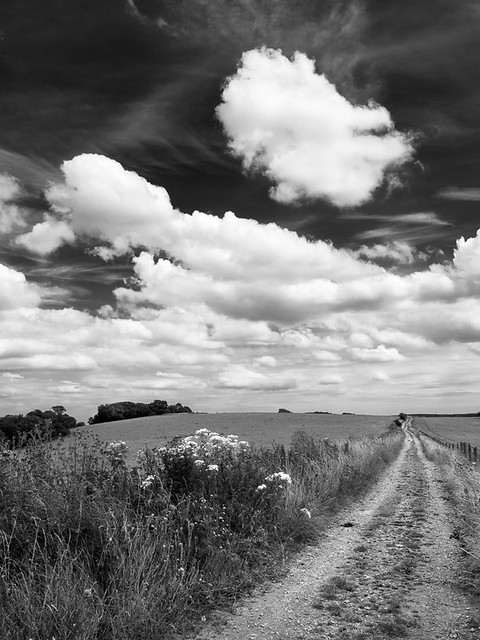 |
| On the Way |
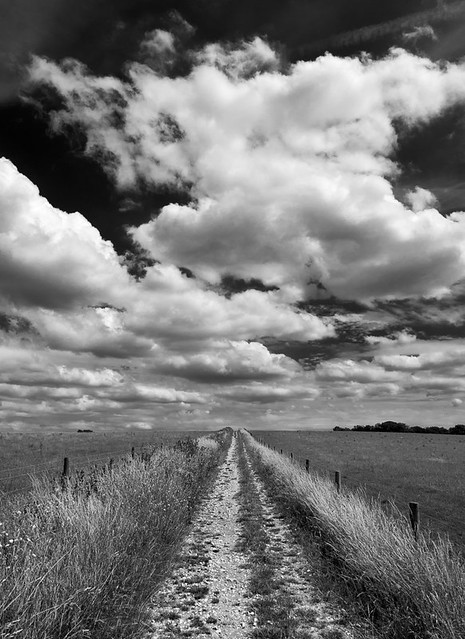 |
| Still heading up hill on the Way |
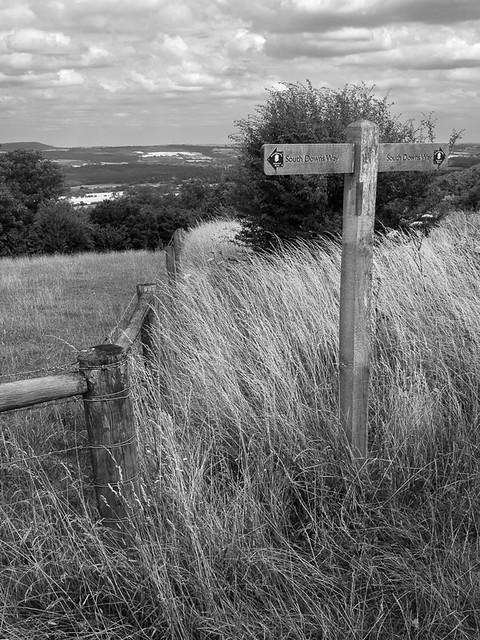 |
| A sign post on the Way |
All the photographs were taken using the Olympus OMD EM5 and Panasonic 12-35mm f2.8 lens. The wonderful clouds made these images what they are. I did not use a polariser but achieved the lovely contrast in the skies in post processing.
Saturday, 27 July 2013
A reminder of a different Summer
As I type this entry the sun is shining and for once we are enjoying a wonderful summer of dry days and very warm temperatures. This was not the case back in 2010 when we went to Wales for our 'summer' holiday. We were staying in a cottage in Ceredigion, in mid Wales. The countryside all around was very beautiful but it was largely overcast and wet. Certainly very different to the weather we have enjoyed in recent weeks. Nevertheless these conditions can provide some good photographic opportunities, as the picture below illustrates.
When this shot was taken (in the first week of August of 2010) I was only just beginning my interest in photography and everything was taken in colour, not black and white. Looking back through the archives I found this image. In colour it really had very little going for it, but when converted to monochrome the three sheep stand out and the rain clouds circling the surrounding hills were typical of the conditions we experienced.
Although I love Scotland, Wales is a little nearer, so I hope it will not be long before I can return and explore the hills and coastline of this unspoilt country.
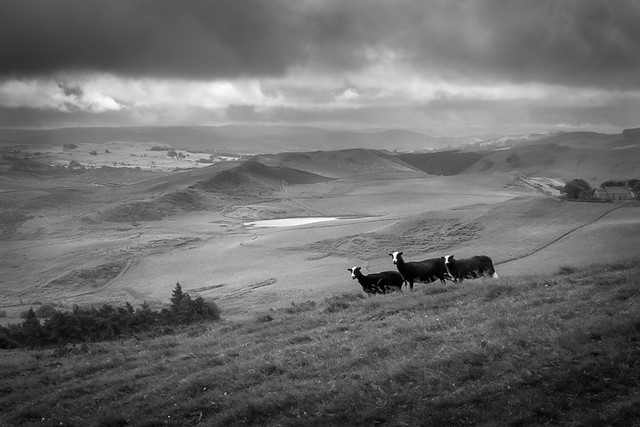 |
| Three sheep on a Welsh hillside |
When this shot was taken (in the first week of August of 2010) I was only just beginning my interest in photography and everything was taken in colour, not black and white. Looking back through the archives I found this image. In colour it really had very little going for it, but when converted to monochrome the three sheep stand out and the rain clouds circling the surrounding hills were typical of the conditions we experienced.
Although I love Scotland, Wales is a little nearer, so I hope it will not be long before I can return and explore the hills and coastline of this unspoilt country.
Saturday, 22 June 2013
Alternative views of the Dorset landscape
The great appeal of landscape photography is the vast variety of subject matter and how just a few steps and a change in viewpoint, can yield two entirely different images.
This is well illustrated by the two pictures in this post. The first, is I guess, a fairly classical treatment of the rolling Dorset hills and fields of barley, taken towards the end of the day on the longest day of the year. It was the shot I had wanted to capture when I returned to this particular location just south of the village of Cheselbourne. The view is of Warren Hill as the road snakes southwards on its way to Puddletown. I used a 3 stop ND filter to slow the shutter speed down to 1/6th of a second to blur the movement in the foreground. The camera was mounted on a tripod.
The light was constantly changing as the clouds circled around me. There was a period when I didn't think the sun would break through. As I waited I walked across to the other side of the road, turned to look the other way, only to see the sun on the grasses, the telegraph pole and the grey clouds behind. So very different to the first shot, but for me it still has a story to tell about the Dorset landscape. For me the telegraph pole with its insulators at the top could be trying to mimic the stems and flower heads of the cowslips below.
Two very different views of Dorset from virtually the same position and both taken within an hour of each other. It has made me think more about the type of photographs I wish to take. Both styles have their merits and personally I enjoy both of them for different reasons. The main lesson is 'look around' there may always be an alternative picture to be taken just over the shoulder.
Tweet
This is well illustrated by the two pictures in this post. The first, is I guess, a fairly classical treatment of the rolling Dorset hills and fields of barley, taken towards the end of the day on the longest day of the year. It was the shot I had wanted to capture when I returned to this particular location just south of the village of Cheselbourne. The view is of Warren Hill as the road snakes southwards on its way to Puddletown. I used a 3 stop ND filter to slow the shutter speed down to 1/6th of a second to blur the movement in the foreground. The camera was mounted on a tripod.
 |
| Fields of barley at Warren Hill |
The light was constantly changing as the clouds circled around me. There was a period when I didn't think the sun would break through. As I waited I walked across to the other side of the road, turned to look the other way, only to see the sun on the grasses, the telegraph pole and the grey clouds behind. So very different to the first shot, but for me it still has a story to tell about the Dorset landscape. For me the telegraph pole with its insulators at the top could be trying to mimic the stems and flower heads of the cowslips below.
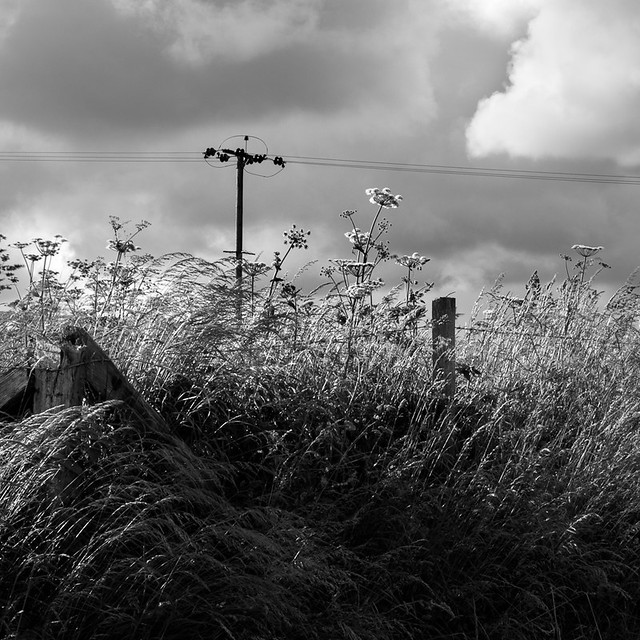 |
| Telegraph pole |
Two very different views of Dorset from virtually the same position and both taken within an hour of each other. It has made me think more about the type of photographs I wish to take. Both styles have their merits and personally I enjoy both of them for different reasons. The main lesson is 'look around' there may always be an alternative picture to be taken just over the shoulder.
Tweet
Saturday, 15 June 2013
A fleeting glimpse and an instinct to return
Something has changed since I started to take my photography more seriously. Quite simply I look at everything around me and consider whether or not it offers an opportunity for me to get out my camera. Inevitably some of these occasions arise when I am out and about, in the car and driving from one place to another. I will fleetingly see a possible composition but without time to stop. I then think to myself whether or not the 'opportunity' is worth a return visit. I also try and pre-visualise the light and more importantly the direction of the light at a particular time of day.
This happened to me the other day when I was returning home from a rather long and tiring day at work. Out of the corner of my eye I saw a field of barley and a house on the horizon. It wasn't the house itself that grabbed my attention but its three chimneys silhouetted against the sky.
The next day I knew that I would be passing the same location, so armed with my camera I returned to see whether or not my fleeting initial glimpse could turn into something worthwhile. I took a number of shots from different positions but I was unsure whether or not I was going to be happy with any of the results.
I returned home only to decide that I would like to go back later in the evening when the light might be better. I explored the location for a second time and felt no more inspired by the composition I was after, so I walked a little further and noticed how the late evening light was shining through the field of barley.
It wasn't until the following morning that I downloaded the files from the memory card to the computer. To my surprise the earlier shots of the 'three chimneys' were the most promising and the best of the bunch is shown above. The light on barley field which was catching one particular ear in the foreground is below.
Having now had the chance to look more closely at these two images I really am pleased I made the effort to return to this location, following what I had seen out of the corner of my eye. I guess my eyes are learning to see - it's such an important part of photography, perhaps the most important part in fact. You can possess the best equipment, have been trained in all the technical skills but unless your eye can truly see, then your ability to take a good image will be severely restricted. That's not to say these are great shots but the fleeting view, combined with my instincts and a desire to return, then I would never have taken these images in the first place.
Both shots were taken hand held, with the Olympus EM5 and Panasonic 35 to 100mm f2.8 lens.
Tweet
 |
| Three chimneys and a field of barley |
This happened to me the other day when I was returning home from a rather long and tiring day at work. Out of the corner of my eye I saw a field of barley and a house on the horizon. It wasn't the house itself that grabbed my attention but its three chimneys silhouetted against the sky.
The next day I knew that I would be passing the same location, so armed with my camera I returned to see whether or not my fleeting initial glimpse could turn into something worthwhile. I took a number of shots from different positions but I was unsure whether or not I was going to be happy with any of the results.
I returned home only to decide that I would like to go back later in the evening when the light might be better. I explored the location for a second time and felt no more inspired by the composition I was after, so I walked a little further and noticed how the late evening light was shining through the field of barley.
It wasn't until the following morning that I downloaded the files from the memory card to the computer. To my surprise the earlier shots of the 'three chimneys' were the most promising and the best of the bunch is shown above. The light on barley field which was catching one particular ear in the foreground is below.
 |
| Barley in light |
Having now had the chance to look more closely at these two images I really am pleased I made the effort to return to this location, following what I had seen out of the corner of my eye. I guess my eyes are learning to see - it's such an important part of photography, perhaps the most important part in fact. You can possess the best equipment, have been trained in all the technical skills but unless your eye can truly see, then your ability to take a good image will be severely restricted. That's not to say these are great shots but the fleeting view, combined with my instincts and a desire to return, then I would never have taken these images in the first place.
Both shots were taken hand held, with the Olympus EM5 and Panasonic 35 to 100mm f2.8 lens.
Tweet
Friday, 7 June 2013
Happy First Birthday to my Blog!
Today this Blog is one year old!
It hardly seems possible that a year has passed since my very first 'blog entry' - 'Finally happy with the design'. It was not the most inspiring of entries and didn't even include a photograph, which is a bit odd for a blog about photography......but I had to start somewhere!
In the twelve months which have followed there have been a total of 72 posts; an average of 6 posts a month. At the outset I really didn't plan or indeed think there would be this many, to the contrary a new idea often turns into a stale one after a short period of time. What has happened in practice is quite the opposite in fact. I have thoroughly enjoyed writing these entries, the vast majority including some of the many photographs I have taken during the course of the year.
The past twelve months has seen a shift in my style of photography, mainly to black and white, and hopefully an improvement in the quality of my work. Looking back I know that I have learnt a great deal, both in terms of the taking but also the making of an image in post production. This now includes some of the skills and equipment required to produce a good print. The more knowledge I have acquired, the greater my realisation that there is even more to learn and that's a big plus, because there are always going to be new challenges to look forward to.
I wanted to mark this day with an image taken just a few days ago. It had been a glorious summer's day and the evening light was just beautiful, as it illuminated the trees lining the footpath and the yellow field of oil seed rape. This is now a common scene across the country, a really colourful feature of the English landscape at this time of year. In a few days time the flower heads will be gone but they are sure to return again next year.
I can't be sure how many people have read this blog over the last 52 weeks, however, irrespective of the number of visits, writing a blog was always intended to be a journal about my photography, which I could look back on as I chart my photographic progress. It was never about reaching out to a wider audience. After all I have no control over who does and who doesn't visit the site anyway.
My enthusiasm for this hobby has grown and grown, so I will continue to post more entries as I learn fresh skills, try new techniques and make more images. This way, when I celebrate it's second birthday, I will be able to review another year to see how far I have come. All I do know is that if the second year is as good as the first, it will be a lot of fun.....and that's what a good hobby should be all about!
Thanks for reading.
Tweet
It hardly seems possible that a year has passed since my very first 'blog entry' - 'Finally happy with the design'. It was not the most inspiring of entries and didn't even include a photograph, which is a bit odd for a blog about photography......but I had to start somewhere!
In the twelve months which have followed there have been a total of 72 posts; an average of 6 posts a month. At the outset I really didn't plan or indeed think there would be this many, to the contrary a new idea often turns into a stale one after a short period of time. What has happened in practice is quite the opposite in fact. I have thoroughly enjoyed writing these entries, the vast majority including some of the many photographs I have taken during the course of the year.
The past twelve months has seen a shift in my style of photography, mainly to black and white, and hopefully an improvement in the quality of my work. Looking back I know that I have learnt a great deal, both in terms of the taking but also the making of an image in post production. This now includes some of the skills and equipment required to produce a good print. The more knowledge I have acquired, the greater my realisation that there is even more to learn and that's a big plus, because there are always going to be new challenges to look forward to.
I wanted to mark this day with an image taken just a few days ago. It had been a glorious summer's day and the evening light was just beautiful, as it illuminated the trees lining the footpath and the yellow field of oil seed rape. This is now a common scene across the country, a really colourful feature of the English landscape at this time of year. In a few days time the flower heads will be gone but they are sure to return again next year.
 |
| Evening light, Idsworth |
I can't be sure how many people have read this blog over the last 52 weeks, however, irrespective of the number of visits, writing a blog was always intended to be a journal about my photography, which I could look back on as I chart my photographic progress. It was never about reaching out to a wider audience. After all I have no control over who does and who doesn't visit the site anyway.
My enthusiasm for this hobby has grown and grown, so I will continue to post more entries as I learn fresh skills, try new techniques and make more images. This way, when I celebrate it's second birthday, I will be able to review another year to see how far I have come. All I do know is that if the second year is as good as the first, it will be a lot of fun.....and that's what a good hobby should be all about!
Thanks for reading.
Tweet
Saturday, 23 March 2013
When mono doesn't always work
Although I largely take black and white photographs there are occasions when I will convert a colour RAW file to mono, only to think that the image looks much better in colour. Stripping out colour can eliminate unwanted distractions in a picture, but equally the colours and harmony of these tones can be at the very heart of the image, so why remove them? As I always shoot in RAW I have a digital negative which contains all the colour data, so it gives me the option of a straight mono conversion or working in colour, whichever I think is the best treatment for the image.
During my recent trip to the Lake District there were two shots I really liked and whilst one is fine in black and white, I much prefer the colour version.
I didn't even consider converting the next shot to monochrome....the colours in the image are just too important in my opinion and make the shot. The warm tones of the foreground contrasting well with the cooler tones in the middle and far distance. These would be lost in a black and white conversion.
This has though made me think. Am I too restrictive in my choice of shot? Should I consider taking more colour images and not be trying to see the world in shades of grey? Surely there is room for both mediums. There can only be a handful of black and white photographers who never shoot in colour. Similarly most photographers who predominately shoot in colour will occasionally take a black and white picture. At the end of the day this is purely a hobby for me, and therefore it's all about the 'taking and making' of images which give me pleasure but hopefully might please others as well. Whether they are black and white or colour doesn't really matter. After all it's simply a matter of personal preference and interpretation.
Tweet
During my recent trip to the Lake District there were two shots I really liked and whilst one is fine in black and white, I much prefer the colour version.
Here are both versions by way of comparison -
and now for the colour version -
 |
| Trees at Elterwater in Langdale |
I didn't even consider converting the next shot to monochrome....the colours in the image are just too important in my opinion and make the shot. The warm tones of the foreground contrasting well with the cooler tones in the middle and far distance. These would be lost in a black and white conversion.
 |
| Looking towards Watson's Dodd taken near to the road from Keswick to Thirlemere |
This has though made me think. Am I too restrictive in my choice of shot? Should I consider taking more colour images and not be trying to see the world in shades of grey? Surely there is room for both mediums. There can only be a handful of black and white photographers who never shoot in colour. Similarly most photographers who predominately shoot in colour will occasionally take a black and white picture. At the end of the day this is purely a hobby for me, and therefore it's all about the 'taking and making' of images which give me pleasure but hopefully might please others as well. Whether they are black and white or colour doesn't really matter. After all it's simply a matter of personal preference and interpretation.
Tweet
Friday, 15 March 2013
Lake District 121 - camera technique at Wasdale Head
On the first morning of my 121 workshop with Paul Gallagher in The Lake District, Paul was keen to establish my camera technique and the typical settings I used. He was not familiar with the Olympus OMD EM5, as he used a Nikon D800E for his digital work, although his preferred system of choice is medium format 5 x 4 Ebony film camera which I was to see in all it's glory a few days later.
We decided to drive to Wastwater and Wasdale Head.
I explained that for landscape work I would use the lowest ISO setting available. In the case of the EM5 this was ISO 200. I would also use Aperture Priority. This way the shutter speed would be automatically selected by the camera. I explained that by using 'live view' on the OMD, I would preview the image by showing a 'shadow and highlights' warning; flashing blue for underexposed areas and flashing orange for overexposed areas or blown highlights. I would then use the exposure compensation dial to make any adjustments in order to balance the exposure. If the dynamic range of the shot was too great for the camera sensor, then it might require the use of a neutral density graduated filter to balance the exposure of say a bright sky with a dark foreground. I told him I would tend to rely upon the camera's auto focus, rarely resorting to manual focus.
Believing this was a tried and tested way of taking landscape photographs I was a little taken aback when Paul suggested that it would be much easier to use manual settings for the exposure and to always focus manually. He went on to explain that by setting the aperture to say f11 or f16 to maximise the depth of field, the shutter speed could be adjusted to obtain the optimum exposure setting using the histogram as a guide. He was fully in favour of exposing to the right, but suggested that the histogram should not be right on the point of clipping the highlights, as this would leave no room for finer adjustments when it came to post processing. This made perfect sense to me and the exposure compensation dial would no longer be needed. If the histogram was not acceptable, a quick change to the shutter speed would bring about the desired result.
Manual focusing is very straightforward with the EM5. Again in using live view, the instant the focus ring was turned on the lens, the screen would magnify the area of view by a factor of 5x. The amount of magnification can be changed in the settings menu. Using the arrow keys on the back of the camera it was easy to select an area of the composition where pin sharp focusing was critical. This would normally be a subject in the foreground. Having preselected a small aperture opening the depth of field should ensure that the background at infinity would also be in sharp focus.
With the camera on the tripod I used the 2 second timer function so that I could press the shutter button and eliminate any camera movement which would spoil the image. Further I turned off the in camera Image Stabilisation as this can 'fight' the lack of movement of a camera mounted on a tripod and try and 'compensate' for movement when none is actually present. Don't ask me how or why, or for a technical explanation, just turn the IS off if using a tripod.
Paul was less concerned about setting the aperture to the optimum opening for the lens, which in the case of some my lenses would be f5.6, as this would rarely give the desired depth of field. Don't worry about using a much smaller aperture he said. It's more important that all parts of the image are in focus, even if the lens was not at its very sharpest aperture setting. Again this advise made perfect sense, so I was already benefitting from his knowledge and expertise and it was still only day one.
With photography over for the day but before heading back to our hotel in Keswick, I visited one of the smallest churches in England - St Olaf in Wasdale Head. This church holds special memories for me and in particular the inscription in the glass of a leaded light window. The words are taken from Psalm 121 and the etching is of Napes Needle on Great Gable. A fitting memorial to all mountaineers and climbers who have visited this beautiful part of the world.
Tweet
We decided to drive to Wastwater and Wasdale Head.
 |
| Wastwater - looking towards Great Gable |
I explained that for landscape work I would use the lowest ISO setting available. In the case of the EM5 this was ISO 200. I would also use Aperture Priority. This way the shutter speed would be automatically selected by the camera. I explained that by using 'live view' on the OMD, I would preview the image by showing a 'shadow and highlights' warning; flashing blue for underexposed areas and flashing orange for overexposed areas or blown highlights. I would then use the exposure compensation dial to make any adjustments in order to balance the exposure. If the dynamic range of the shot was too great for the camera sensor, then it might require the use of a neutral density graduated filter to balance the exposure of say a bright sky with a dark foreground. I told him I would tend to rely upon the camera's auto focus, rarely resorting to manual focus.
Believing this was a tried and tested way of taking landscape photographs I was a little taken aback when Paul suggested that it would be much easier to use manual settings for the exposure and to always focus manually. He went on to explain that by setting the aperture to say f11 or f16 to maximise the depth of field, the shutter speed could be adjusted to obtain the optimum exposure setting using the histogram as a guide. He was fully in favour of exposing to the right, but suggested that the histogram should not be right on the point of clipping the highlights, as this would leave no room for finer adjustments when it came to post processing. This made perfect sense to me and the exposure compensation dial would no longer be needed. If the histogram was not acceptable, a quick change to the shutter speed would bring about the desired result.
 |
| Looking across Wastwater to the Screes |
Manual focusing is very straightforward with the EM5. Again in using live view, the instant the focus ring was turned on the lens, the screen would magnify the area of view by a factor of 5x. The amount of magnification can be changed in the settings menu. Using the arrow keys on the back of the camera it was easy to select an area of the composition where pin sharp focusing was critical. This would normally be a subject in the foreground. Having preselected a small aperture opening the depth of field should ensure that the background at infinity would also be in sharp focus.
With the camera on the tripod I used the 2 second timer function so that I could press the shutter button and eliminate any camera movement which would spoil the image. Further I turned off the in camera Image Stabilisation as this can 'fight' the lack of movement of a camera mounted on a tripod and try and 'compensate' for movement when none is actually present. Don't ask me how or why, or for a technical explanation, just turn the IS off if using a tripod.
Paul was less concerned about setting the aperture to the optimum opening for the lens, which in the case of some my lenses would be f5.6, as this would rarely give the desired depth of field. Don't worry about using a much smaller aperture he said. It's more important that all parts of the image are in focus, even if the lens was not at its very sharpest aperture setting. Again this advise made perfect sense, so I was already benefitting from his knowledge and expertise and it was still only day one.
With photography over for the day but before heading back to our hotel in Keswick, I visited one of the smallest churches in England - St Olaf in Wasdale Head. This church holds special memories for me and in particular the inscription in the glass of a leaded light window. The words are taken from Psalm 121 and the etching is of Napes Needle on Great Gable. A fitting memorial to all mountaineers and climbers who have visited this beautiful part of the world.
 |
| The etching and inscription in St Olaf Church at Wasdale Head |
Tweet
Wednesday, 6 February 2013
Lone sheep in Dorset
It has been so wet in the past few months with very little sunshine, so it was a real treat to be in Dorset a few days ago to experience a lovely winter's day when the sun shone and it cast it's little bit of magic on the rolling hills of this part of the West Country.
As we drove around the Piddle Valley (great name this!), which lies to the north of the County Town of Dorchester, we came across the view below. Bathed in late afternoon sun, long shadows fell across the ground and the backlit sheep added life and foreground interest to this rather archetypal English landscape.
Nothing more to add, just enjoy the view - I know I did.
Tweet
As we drove around the Piddle Valley (great name this!), which lies to the north of the County Town of Dorchester, we came across the view below. Bathed in late afternoon sun, long shadows fell across the ground and the backlit sheep added life and foreground interest to this rather archetypal English landscape.
Nothing more to add, just enjoy the view - I know I did.
 |
| Lone sheep |
Tweet
Saturday, 19 January 2013
The first snow of winter
Here on the South Coast of England snow is a relatively rare thing but the weather forecast a few days ago told us of its imminent arrival and on this occasion their prediction came true. On Friday morning the snow started to fall and within the space of a few hours there was a thick blanket of the 'white cold stuff' covering the ground. Tempted to venture out, I decided to wait until the following day when the snow would no longer be falling and it would be easier to get around.
The presence of snow offers the black and white photographer so many opportunities. The grey heavy skies, bare winter trees all contrasting with the pure white snow. Whilst a ray of sunshine would not go amiss to boost this contrast even further, in many ways an overcast sky is easier to handle and adds to the atmosphere of the shot.
The images below were all taken with the Olympus EM5 and my new 12 - 35 Panasonic zoom lens which has a constant aperture of f2.8. This is the first time I have been out with this combination. All other 'gear' was left at home and I have to say in these cold conditions it was a real benefit to have just one lens on the camera. The thought of switching lenses, not to mention the need to take gloves on and off all the time, made for a more enjoyable walk and photographic experience.
Tweet
The presence of snow offers the black and white photographer so many opportunities. The grey heavy skies, bare winter trees all contrasting with the pure white snow. Whilst a ray of sunshine would not go amiss to boost this contrast even further, in many ways an overcast sky is easier to handle and adds to the atmosphere of the shot.
The images below were all taken with the Olympus EM5 and my new 12 - 35 Panasonic zoom lens which has a constant aperture of f2.8. This is the first time I have been out with this combination. All other 'gear' was left at home and I have to say in these cold conditions it was a real benefit to have just one lens on the camera. The thought of switching lenses, not to mention the need to take gloves on and off all the time, made for a more enjoyable walk and photographic experience.
 |
| Lone tree |
 |
| Field of snow and ice |
 |
| Cow parsley |
 |
| Skeleton of a tree |
 |
| Grasses in the snow |
 |
| Tree in winter |
Tweet
Wednesday, 9 January 2013
Photographic books - not new camera gear!
Some time ago I remember reading on Eric Kim's blog that many aspiring photographers would be better to invest their money in good books on photography as opposed to the latest camera gear. This comment struck a chord with me and whilst I can be accused of spending quite a lot of money on my Olympus Micro 4/3rds system last year, at the same time I have also tried to build up a small collection of books. Some cover camera technique and processing, others photographs of a certain genre, landscape for example, or and perhaps most importantly on the work of people I admire.
One such photographer is Michael Kenna, whose exhibition in London I visited recently. I am all too aware that there are many amateurs (and professionals) who have tried to emulate his style or worse still copy his work - plagarism I think its called, but in the photographic art world he is still seen as a master craftsman, creating superb images which can be enjoyed on so many levels.
I was therefore very fortunate to be given for Christmas his two 'Retrospective' books, both of which have been signed by him. I am sure he signed many copies, but for me it makes them rather special having his signiature on the inside.
One such photographer is Michael Kenna, whose exhibition in London I visited recently. I am all too aware that there are many amateurs (and professionals) who have tried to emulate his style or worse still copy his work - plagarism I think its called, but in the photographic art world he is still seen as a master craftsman, creating superb images which can be enjoyed on so many levels.
I was therefore very fortunate to be given for Christmas his two 'Retrospective' books, both of which have been signed by him. I am sure he signed many copies, but for me it makes them rather special having his signiature on the inside.
Saturday, 29 September 2012
Photo opportunities - always have a camera with you
So often when out and about, I see something and say to myself if only I had my camera with me. Every photographer will have uttered those words at some time and probably more than once! Well from now on I will try and avoid that mistake. I will also follow the saying which states - 'the best camera, is the one you have with you'. How true is that! The next couple of images were taken on the way to somewhere else, with no intention whatsoever of releasing the shutter on the journey but on both occasions I did have a camera in the car.
The first is a shot of the late afternoon light on the South Downs in West Sussex between the villages of Amberley and Storrington. This was captured with the Olympus EM5 and 45mm 1.8 prime lens. Its not the best landscape photograph I have ever taken but I think its quite pleasing and I wouldn't have it at all, if I hadn't got the camera with me.
The first is a shot of the late afternoon light on the South Downs in West Sussex between the villages of Amberley and Storrington. This was captured with the Olympus EM5 and 45mm 1.8 prime lens. Its not the best landscape photograph I have ever taken but I think its quite pleasing and I wouldn't have it at all, if I hadn't got the camera with me.
Subscribe to:
Posts (Atom)



